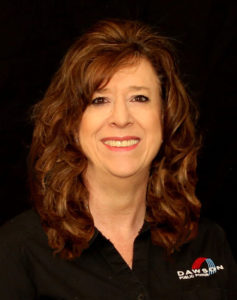
Gwen Kautz, Dawson Public Power District General Manager
By Gwen Kautz, Dawson PPD General Manager
gkautz (at) dawsonpower.com
308-324-2386
When we hear the word, “teamwork,” it’s generally associated with a sporting event or a work project. Teamwork took on a whole new meaning for me last month.
I was invited to sit in on a meeting where neighboring public power districts as well as municipalities (inside our service footprint) discussed the upgrade or construction of power lines needed to provide reliable electric service to everyone in our part of the state. Prior to 1999, systems did not do coordinated joint planning with their neighbors.
It gave me pause to ask whether our customers knew every utility in Nebraska is connected together by the power line system. There are several classes of power lines, but I’m going to talk about the class called subtransmission lines, or 34.5 and 69 kV lines (34,500 and 69,000 V). These lines move power from the “high-voltage” transmission system to the substations that feed distribution lines. Distribution lines carry power ranging from 2,400 V to 12,500 V to the transformer near your house where it is converted to the lower voltage needed to power your home.
Because of the way the electrical grid evolved, Nebraska Public Power District and sister utilities often operated subtransmission lines within the same territorial footprint. The NPPD lines typically served smaller communities. It made sense for local utilities to take responsibility for serving consumers in those smaller communities and the lines serving them. So, in 1998, several small towns were reassigned to local public power districts. A mechanism was needed to coordinate subtransmission planning within and between member utilities for the benefit of all consumers, both rural and urban.
Thus, the Joint Sub-Transmission Planning Group was created to ensure that the best interests of public power customers were served by working cooperatively. Without this effort, load growth would not be addressed in a timely manner, nor would safety and reliability. That’s not to say systems wouldn’t continue to improve their facilities without joint planning.
[su_pullquote]Our job is to make sure you have power – and not just any power – safe, affordable and RELIABLE power. [/su_pullquote]The Planning Group has no real authority except what is agreed to in planning sessions. However, each utility has committed to provide 24-hour response for operations required to maintain a safe and reliable (interconnected) system. They also provide oversight in general and maintain a high level of communication by designating specific contact people at each organization. In the end, each utility is responsible for the quality of service that its consumers receive.
In these planning meetings, we are looking at millions of dollars. That’s another reason planned coordination is necessary. A system does not need to spend that kind of money if it leads to nowhere. The group looks at the entire state and notes expected load growth reported by each system. The interconnectivity has to be reliable or we’d topple like dominoes in a crisis.
There were many technical things I didn’t understand in this meeting. What I saw, however, were municipals, public power districts and our wholesale supplier sit down and talk candidly about what Nebraskans need from their electric providers. The sharing of system knowledge showed the group’s flexibility in changing certain elements so everyone got benefit.
In the next five years, Dawson PPD is looking at over $7 million dollars in sub-transmission builds or upgrades. As I began to object, I noted that every system sitting in the room was also talking about plant investments in the millions of dollars that would be spent to protect reliability as a whole. To put our own piece into perspective, each year Dawson PPD reinvests about $2 million dollars just to maintain a healthy system. So, joint planning stays within our budget constraints, yet benefits all with maximum results.
Our job is to make sure you have power – and not just any power – safe, affordable and RELIABLE power.
May 2017
